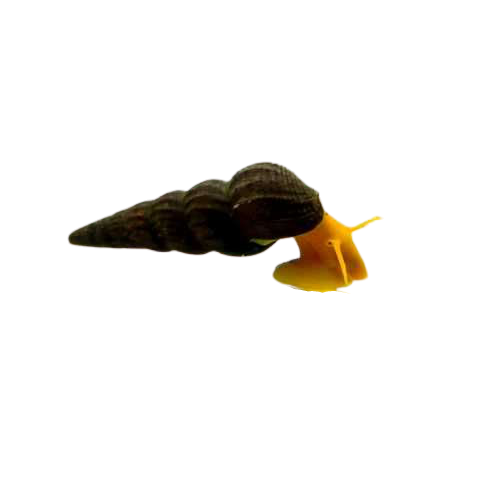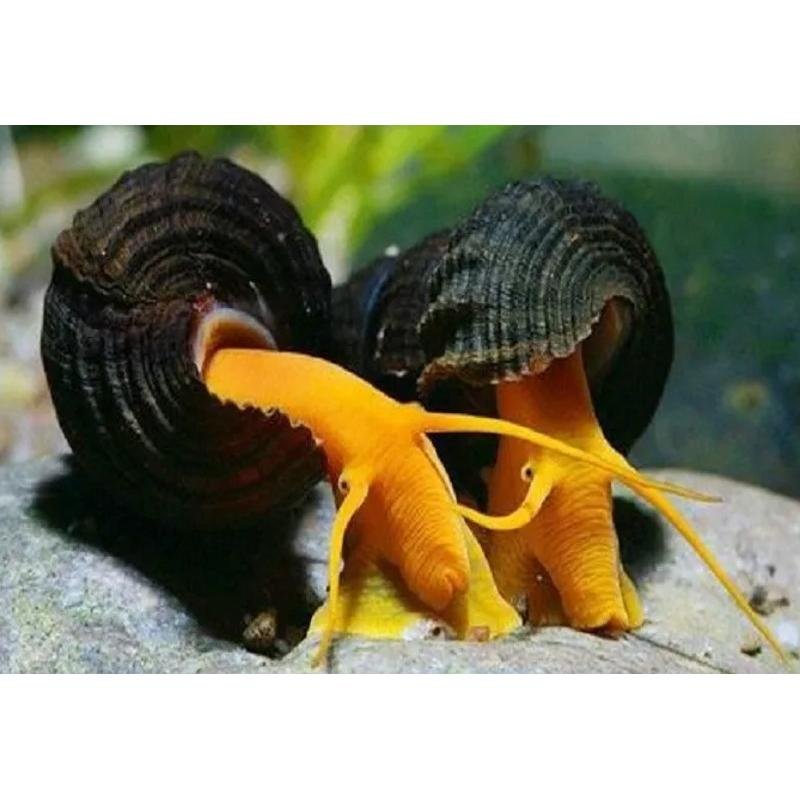Rabbit Snail
R100.00
Before ordering live fish, please click to check if we can safely ship livestock to your location.
Please note that fish image is a representation of what the fish might look like as an adult.
Rabbit Snails (Tylomelania) are a relatively new freshwater invertebrate to grace the fish-keeping community. They were first introduced to the market around 2007. Thus, they’re still quite rare. However, those that are lucky enough to own them usually have nothing but good things to say. Named for their appearance, Rabbit Snails have two dropping antennae that resemble rabbit ears, as well as rabbit-like facial features.
They originate in Sulawesi, Indonesia, where they can be found in lakes in the mountains. Unique in appearance and peaceful in character, Rabbit Snails add a special touch to your community aquarium of at least 100 litres.
Behavior
Rabbit Snails are really active and love to wander around the tank all day and fun to watch. As they walk, they drag their foot, which moves through muscle contractions. As the muscles contract, their shells arch and they pull their spiral shell along with them. During their wandering, they will be completely uninterested in anyone around them. They are loners, but not afraid to be out and about in the open. Most of what they do is look for ways to clean your tank. They scoop up algae and detritus so you don’t have a buildup in your aquarium.
Sometimes they just need a day of rest. Not to worry if your Rabbit Snail retreats into its shell and does nothing. It’s likely just resting. It should pop back out in a day or two. They can stay awake for more than 30 hours at a time, and they are very active while they are awake. However, after all this activity, it’s not unusual for them to curl up and sleep for long periods.
Tank Conditions
A 100 litre community tank is recommend for Rabbit Snails. They need enough space to move around the tank and enough algae and other debris to eat. Also they are larger than most other snails. They are suited to be paired with peaceful fish, so you can easily add fish to the mid and top levels of the tank to fully populate the tank without overcrowding it.
For substrate, choose fine sand so that the Rabbit Snails do not scrape themselves on the substrate. They are burrowers and can go down pretty deep. The sand is also similar to what they will encounter in their natural habitat in Indonesia, which makes them happy.
To keep these snails comfortable, keep your tank full of live vegetation. This not only looks nice but also gives plenty of natural food. They love it when dead pieces of plant fall to the bottom for them to eat. Common plants to include are Java Moss, and Hornwort; all of which are incredibly hardy. The only plant you might want to avoid is the Java Fern, which they tend to eat live if they are hungry. But if you’re feeding them enough, you shouldn’t run into an issue.
These snails tend to crawl out of the water, especially when food is low. Use a tight-fitting lid to ensure that all your snails stay in your aquarium.
Compatibility
Rabbit Snails are super peaceful and are not a threat to any other species. Do not place Rabbit Snails with fish that will be a threat to them. Pair them with tank mates that are not aggressive or likely to eat them. Try peaceful fish such as tetras, shrimp or larger fish that will mostly ignore the snails. The amount of snails you can have in your aquarium completely depends on how many fish you’re going to keep them with. As a rough indication you can include around 1 snail per 100 litres. Just make sure they have enough algae to eat.
Rabbit Snail shells are longer and pointier than other snail shells. The opening is shaped like an oval, where you will find the operculum, or trap door, where the Rabbit Snail can hide in case of threat or danger. The operculum does not provide complete protection since it does not cover the whole opening, leaving the Rabbit Snails partially exposed to predators.
Feeding
Rabbit Snails are scavengers, and one of the reasons that they are desirable aquarium dwellers is that they are tank cleaners. Rabbit Snails will happily make sure to cut down on the number of algae and detritus in your tank.
They will also snack on leftover food that floats down from mid and top-level fish. However, they do need you to provide them with sources of nutrition in order to ensure sufficient nutrition. Calcium is necessary to keep their shells strong and protect them from predators. Some healthy options to offer your Rabbit Snails include:
- Algae wafers
- Blanched broccoli
- Blanched spinach
- Sinking Pellets
Besides vegetables and fish food pellets, rabbit snails also eat all kinds of other food if available.
If algae isn’t forming fast enough then you should add in other foods and/or enhance algae growth by keeping your tank lights on longer. Algae wafers make good substitutes, especially since they sit on the bottom of the tank until a snail comes across them.
Care
Rabbit Snails will not need a whole lot of extra care as long as you provide them with optimal water parameters. They are not going to be at risk of contracting the common diseases that attack aquarium fish, such as Ich (they can be carriers, though.)
Copper is deadly for Rabbit Snails, so if you are using a medication to treat your fish, check the label to see if it has copper. If it does, treat your fish in a separate tank so that the Rabbit Snails are not exposed to the copper.
Maintaining water stability will go a long way to ensuring that your Rabbit Snails thrive–instability increases stress, threatens their health, and compromises shell integrity.
In general one should apply the same rules for water quality as with fish (ammonia, nitrite, nitrate etc) and the water should not be too soft. Like most snails, Rabbit Snails prefer calcium rich water. If the calcium concentration in the water isn’t high enough (soft water), they aren’t able to build a strong shell and become susceptible to shell damage, but even in good conditions, some snails still get little holes in the shell surface, especially in the older parts of their shell. This is a naturally occurring process and as long it’s only at the surface, you shouldn’t worry too much about it.
Because of their sensitivity to ammonia and nitrates, you will also need a pretty strong filter to rid the water of these harmful elements.
As for water conditions, the numbers are straightforward:
- pH level range: 7.3 – 8.5
- Temperature range: 20°C-30°C
- Water hardness: 2-15 dKH (hard is better because it has more calcium)
The thing to keep note here is the relatively high pH. Low levels of pH can start to dissolve the calcium carbonate shells of the snails leaving them open to harm from other fish. Cracked, thin, or pitted shells can be a sign of low pH as well as low levels of calcium. Adding calcium supplements (note – shrimp minerals work well) can help ensure their shells are strong and healthy.
Breeding
Despite their name, Rabbit Snails are not super fast breeders. Unlike other snails, they only have one or two baby snails per breeding cycle, so overpopulation will not be an issue.
In a process that is fascinating to witness, the male Rabbit Snail passes a ball of sperm to the female, who hangs on to it until she is ready to lay her eggs (or egg). The egg is gelatinous and resembles a small pearl. After a very short incubation time, the baby snail emerges from the egg, looking like a mini Rabbit Snail. As soon as the carbon copy babies are born, complete with a fully formed shell, they will start their lives as scavengers, searching for food right away.
| Category | Rating |
|---|---|
| Adult Size: | 8 cm |
| Aquarist Experience Level: | Beginner |
| Minimum Tank Size: | 100 litres |
| Temperament: | Peaceful Community |
| Tank Level: | Bottom dweller, burrower |
| Diet: | Omnivore |
| Aquarium Hardiness: | Hardy |
| Lifespan: | 1 – 3 Years |
| Water Flow: | Slow |
| Temperature: | 20 to 30°C |
| pH: | 7.3 – 8.5 higher is better |
| Hardness: | 2 – 15 dKH harder is better |
Shipping Countries: South Africa
Shipping States: Gauteng (South Africa)
Specification: Rabbit Snail
| Weight | 0.25 kg |
|---|

Budget Cage 1500 x 600 x 600

Super Hypo Leopard Gecko

Willow Grass 250mm
Product Enquiry

R100.00

















There are no reviews yet.